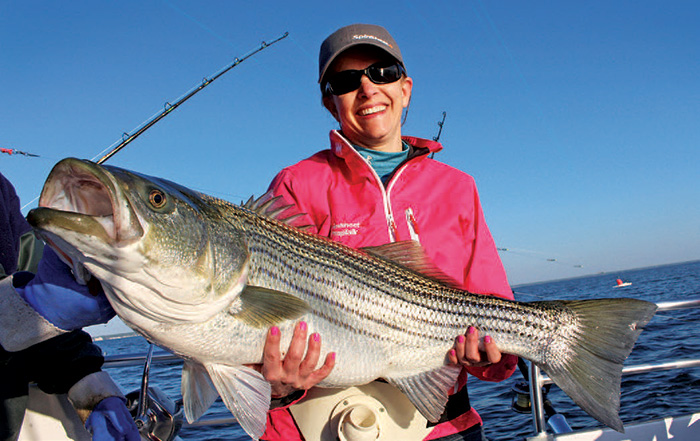Advertisement
Which is more important — lightweight or durability? We cast some new light on modern fishing rod technology.

Photo: Jim Gallop
Today you can buy a 6-foot fishing rod that barely outweighs a No. 2 pencil, yet has the strength to swing a 10-pound bass over the gunwale. How can this be possible? Advanced technology — and some serious competition in the fishing tackle market — have been the driving forces. Here's how high-tech materials and construction have changed our angling armaments.
Strength Vs. Weight
In many situations, anglers cast, hold, and jig their rods for hours on end. And while a fishing rod may feel light at first, by the end of the day, small weight differences have a huge effect. Space-age materials like graphite and carbon fiber have allowed builders to trim a lot of the weight out of their rods, while also making them more sensitive than the older standby — fiberglass. But there's a trade-off: The lighter and more sensitive a rod, the less durable it's likely to be.
"There's a balance you have to find," explains Lucas Holgren, of Lamniglass, which has been building fishing rods since 1949 and has seen generations of rod-building materials come and go. "You can make a rod more powerful, or you can make it lighter or more sensitive. But you can't do all at once in the same rod."
Graphite, found in most high-end rods these days, is measured by modulus. The higher the modulus, the stiffer the graphite — and the less material you'll need to attain stiffness. The wall of the rod (which is hollow) can be made thinner, and the rod is thus lighter. Those incredibly thin walls, however, can be more brittle and subject to damage. While they rarely fail under normal use, any chink in their armor caused by things like a drop to the deck, hitting a rocket launcher during a cast, or being stepped on, can result in catastrophic failure when the rod bends over under the strain of a fish. Most rod builders overcome this by using a composite blend of graphite and fiberglass, which may add a bit of weight, but significantly enhances durability.
Pieces And Parts
Aside from the rod blank (the graphite/fiberglass core of the rod to which additional sections are added), other materials used in the rod's components also play a role in reducing weight. While traditional cork remains one of the lightest materials used for grips, the reel seat and its inserts, handle trim, and rod butt material are all places where more weight can be shed. Graphite and — more recently — carbon fiber are often the materials used to do it.

In situations where strength trumps sensitivity and weight, such as trolling heavy gear for big striped bass, fiberglass or mostly fiberglass rods are far more common that those with higher graphite content. (Photo: Lenny Rudow)
Custom rod builder Steve Fogle, of Backyard Custom Rods, says that most of his customers feel that lighter is always better. Even when it comes to big-game fishing rods, weight counts. "You just can't get anything stronger than aluminum for a rod butt," he notes, "but you'll have to pay for that strength with weight." He also points out, however, that many of today's components are lighter than those built in the past, thanks to design.
A great example of changing designs can be found in the handles, with the advent of "split-grips," which Fogle says have become extremely popular. This style of handle has a short grip at the reel seat, exposed blank for several inches, then another small handle at the butt. Just eliminating that few inches of grip material does result in weight savings (which varies depending on the size and style or the rod, and the material being used).
More fractions of an ounce are shaved off with the rod's guides. While stainless steel combined with aluminum-oxide guide liners have long been common fare, the newest high-end rods often have titanium guides with silicon carbide (SiC) or Alconite liners. Similar durability trade-offs are made, however, because while stainless-steel guides are prone to being bent, they can also be bent back into shape. Titanium guides, on the other hand, are more likely to merely snap.
Weighty Decisions
Just how much weight are we talking about? It may be mere fractions of an ounce here and there, but think back to our original assertion, that modern rods can come close to the weight of a No. 2 pencil. That pencil tips the scales at about one-third of an ounce. A 6-foot, 6-inch St. Croix Avid spinning rod (a popular choice among modern freshwater anglers) weighs in at 2.5 ounces. OK, so maybe we stretched it a bit with that comparison, but think about 2.5 ounces for just a second. That's no heavier than a large gulp of water. It's less than an average bar of soap, and it's half the weight of the newest iPhone. In fact, if you caught a fish so small that weighed just 2.5 ounces you'd probably be too embarrassed to snap off that iPhone selfie.
Now consider how many casts an angler might make in a day. According to Sports Illustrated, pro basser Tommy Martin has been clocked at 12 casts a minute. If an average angler casts just one-twelfth as much, he or she would be slinging their fishing rod about 500 times during the course of an eight-hour day of fishing. In that amount of time, an angler using an old-tech rod weighing twice as much would be cumulatively casting 1,250 additional ounces. By the end of the day could you feel the difference? Absolutely, especially after adding in the weight of all those 10-pound bass you've been swinging over the gunwales!
